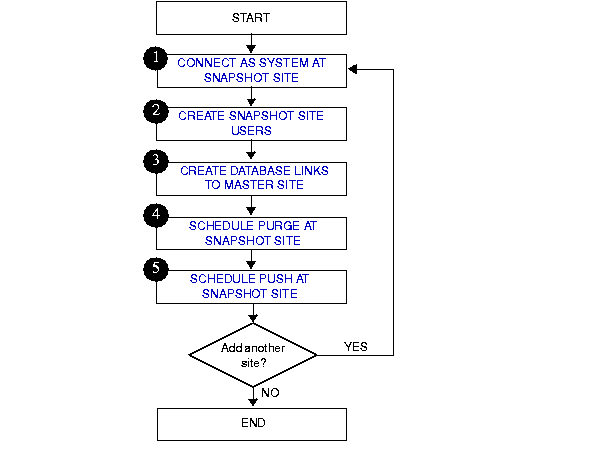Release 2 (8.1.6)
Part Number A76958-01
Library |
Product |
Contents |
Index |
| Oracle8i Replication Management API Reference Release 2 (8.1.6) Part Number A76958-01 |
|
Create Replication Site, 4 of 4

/************************************************************************* STEP 1: CONNECT AS SYSTEM AT SNAPSHOT SITE *************************************************************************/ --You must connect as SYSTEM to the database that you want to --set up as a snapshot site. CONNECT system/manager@snap1.world /************************************************************************* STEP 2: CREATE SNAPSHOT SITE USERS *************************************************************************/ --Several users need to be created at the snapshot site. These users are: -- SNAPSHOT ADMINISTRATOR -- PROPAGATOR -- REFRESHER --STEP 2a: CREATE SNAPSHOT ADMINISTRATOR --The snapshot administrator is responsible for creating and managing --the snapshot site. Execute the GRANT_ADMIN_ANY_SCHEMA --procedure to grant the snapshot administrator the appropriate privileges. create user SNAPADMIN identified by SNAPADMIN; BEGIN DBMS_REPCAT_ADMIN.GRANT_ADMIN_ANY_SCHEMA ( username => 'SNAPADMIN'); END; / --STEP 2b: CREATE PROPAGATOR --The propagator is responsible for propagating the deferred transaction --queue to the target master site. CREATE USER propagator IDENTIFIED BY propagator; BEGIN DBMS_DEFER_SYS.REGISTER_PROPAGATOR ( username => 'propagator'); END; / --STEP 2c: CREATE REFRESHER --The refresher is responsible for "pulling" changes made to the replicated --tables at the target master site to the snapshot site. create user REFRESHER identified by REFRESHER; GRANT CREATE SESSION TO refresher; GRANT ALTER ANY SNAPSHOT TO refresher; /************************************************************************* STEP 3: CREATE DATABASE LINKS TO MASTER SITE *************************************************************************/ --STEP 3A: CREATE PUBLIC DATABASE LINK CONNECT system/manager@snap1.world CREATE PUBLIC DATABASE LINK orc1.world USING 'orc1.world'; --STEP 3b: CREATE SNAPSHOT ADMINISTRATOR DATABASE LINK --You need to create a database link from the snapshot administrator at --the snapshot site to the proxy snapshot administrator at --the master site. CONNECT snapadmin/snapadmin@snap1.world; CREATE DATABASE LINK orc1.world CONNECT TO proxy_snapadmin IDENTIFIED BY proxy_snapadmin; --STEP 3c: CREATE PROPAGATOR/RECEIVER DATABASE LINK --You need to create a database link from the propagator at the --snapshot site to the receiver at the master site. The receiver was defined --when you created the master group - see "REGISTER RECEIVER" --for more information. CONNECT propagator/propagator@snap1.world CREATE DATABASE LINK orc1.world CONNECT TO repadmin IDENTIFIED BY repadmin; /************************************************************************* STEP 4: SCHEDULE PURGE AT SNAPSHOT SITE For additional information about the SCHEDULE_PURGE API, see "SCHEDULE_PURGE procedure". *************************************************************************/ --In order to keep the size of the deferred transaction queue in check, --you should purge successfully completed deferred transactions. The --SCHEDULE_PURGE API automates the purge process for you. If your snapshot --site only contains "read-only" snapshots, then you do not need to --execute this procedure. CONNECT snapadmin/snapadmin@snap1.world BEGIN DBMS_DEFER_SYS.SCHEDULE_PURGE ( next_date => SYSDATE, interval => 'sysdate + 1/24', delay_seconds => 0, rollback_segment => ''); END; / /************************************************************************* STEP 5: SCHEDULE PUSH AT SNAPSHOT SITE For additional information about the SCHEDULE_PUSH API, see "SCHEDULE_PUSH procedure". *************************************************************************/ --The SCHEDULE_PUSH API schedules when the deferred transaction queue --should be propagated to the target master site. CONNECT snapadmin/snapadmin@snap1.world BEGIN DBMS_DEFER_SYS.SCHEDULE_PUSH ( destination => 'ORC1.WORLD', interval => 'sysdate + 1/24', next_date => SYSDATE, stop_on_error => FALSE, delay_seconds => 0, parallelism => 0); END; /
|
|
 Copyright © 1996-2000, Oracle Corporation. All Rights Reserved. |
|